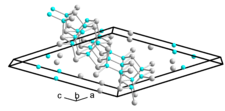Tellurure de gallium(II)
| Tellurure de gallium(II) | |

| |
| __ Ga2+ __ Te2- Maille cristalline du tellurure de gallium(II) |
|
| Identification | |
|---|---|
| Nom UICPA | tellanylidènegallium |
| Nom systématique | tellurure de gallium(II) |
| No CAS | |
| No ECHA | 100.031.524 |
| No CE | 234-690-1 |
| PubChem | 14496722 |
| SMILES | |
| InChI | |
| Apparence | solide inodore[1] |
| Propriétés chimiques | |
| Formule | GaTe |
| Masse molaire[2] | 197,32 ± 0,03 g/mol Ga 35,34 %, Te 64,67 %, |
| Propriétés physiques | |
| T° fusion | 824 °C[3] |
| Masse volumique | 5,751 g/cm3[3] |
| Précautions | |
| SGH[1] | |
| H302, H315, H319, H335, P280, P312, P301+P330+P331, P302+P352, P304+P340, P332+P313 et P337+P313 |
|
| NFPA 704[1] | |
| Unités du SI et CNTP, sauf indication contraire. | |
| modifier |
|
Le tellurure de gallium(II) est un composé chimique de formule GaTe. C'est un semi-conducteur à gap direct[4] avec une largeur de bande interdite de 1,65 eV[5],[6]. Il se présente sous la forme de flocons noirs, mous, aux reflets gras et brillants, s'écrasant facilement.
On le connaît sous quatre structures cristallines, les deux polymorphes principaux étant l'α-GaTe, cristallisé dans le système monoclinique selon le groupe d'espace C2/m (no 12), et le β-GaTe, cristallisé dans le système hexagonal selon le groupe d'espace P63/mmc (no 194), comme le séléniure de gallium(II) GaSe. Dans la forme α, chaque atome de gallium est lié à un autre atome de gallium et à trois atomes de tellure, ce qui donne une géométrie tétraédrique. Chaque atome de tellure est, quant à lui, lié à trois atomes de gallium dans une géométrie pyramidale trigonale, ce qui donne une structure feuilletée. La forme β est métastable et donne la forme α à haute température[7]. Les autres polymorphes de GaTe sont monocliniques[3],[8],[9].
Le tellurure de gallium(II) peut être obtenu par réaction directe de gallium métallique avec du tellure élémentaire[3] :
Il est également possible de le faire croître par MOCVD[10].
Notes et références
[modifier | modifier le code]- « Fiche du composé Gallium(II) telluride, 99.999% (metals basis) », sur Alfa Aesar (consulté le ).
- ↑ Masse molaire calculée d’après « Atomic weights of the elements 2007 », sur www.chem.qmul.ac.uk.
- (de) Georg Brauer, en collaboration avec Marianne Baudler, Handbuch der Präparativen Anorganischen Chemie, 3e éd. révisée, vol. 1, Ferdinand Enke, Stuttgart, 1975, p. 861. (ISBN 3-432-02328-6)
- ↑ (en) Jose Javier Fonseca Vega, « Bandgap Engineering of Gallium Telluride » [PDF], sur escholarship.org, UC Berkeley Electronic Theses and Dissertations, (Bibcode 2017PhDT.......106F, consulté le ), p. 1.
- ↑ (en) Jose J. Fonseca, Sefaattin Tongay, Mehmet Topsakal, Annabel R. Chew, Alan J. Lin, Changhyun Ko, Alexander V. Luce, Alberto Salleo, Junqiao Wu et Oscar D. Dubon, « Bandgap Restructuring of the Layered Semiconductor Gallium Telluride in Air », Advanced Materials, vol. 28, no 30, , p. 6465-6470 (PMID 27171481, DOI 10.1002/adma.201601151, Bibcode 2016AdM....28.6465F, lire en ligne).
- ↑ (en) A. Aydinli, N. M. Gasanly, A. Uka et H. Efeoglu, « Anharmonicity in GaTe layered crystals », Crystal Research & Technology, vol. 37, no 12, , p. 1303-1309 (DOI 10.1002/crat.200290006, lire en ligne).
- ↑ (en) Edward D. Palik, Handbook of Optical Constants of Solids, Academic Press, 1998, p. 489. (ISBN 0-12-544423-0)
- ↑ (en) V. Grasso, Electronic Structure and Electronic Transitions in Layered Materials, Springer, 1986, p. 232. (ISBN 90-277-2102-5)
- ↑ (en) N. N. Kolesnikov, E. B. Borisenko, D. N. Borisenko et A. V. Timonina, « Structure and microstructure of GaTe crystals grown by High-Pressure vertical zone melting », Journal of Crystal Growth, vol. 365, , p. 59-63 (DOI 10.1016/j.jcrysgro.2012.11.038, Bibcode 2013JCrGr.365...59K, lire en ligne).
- ↑ (en) Edward G. Gillan et Andrew R. Barron, « Chemical Vapor Deposition of Hexagonal Gallium Selenide and Telluride Films from Cubane Precursors: Understanding the Envelope of Molecular Control », Chemistry of Materials, vol. 9, no 12, , p. 3037-3048 (DOI 10.1021/cm9703886, lire en ligne).

